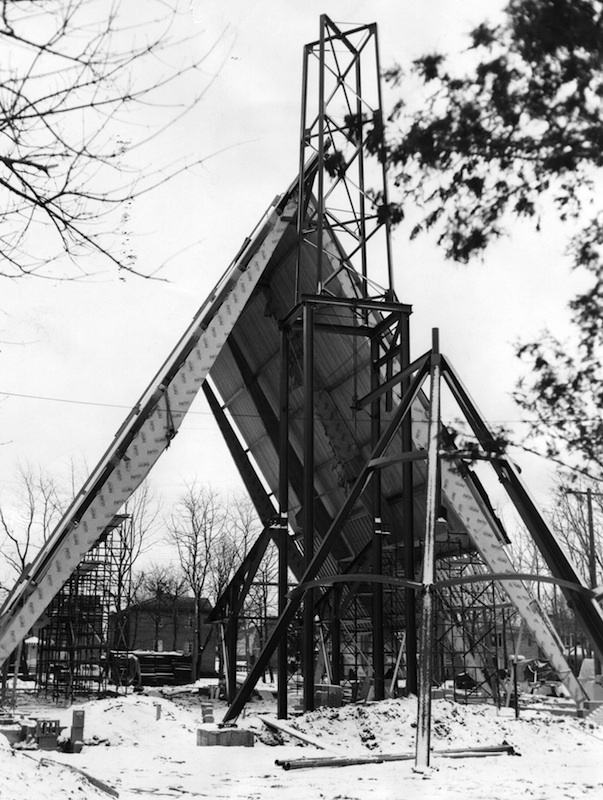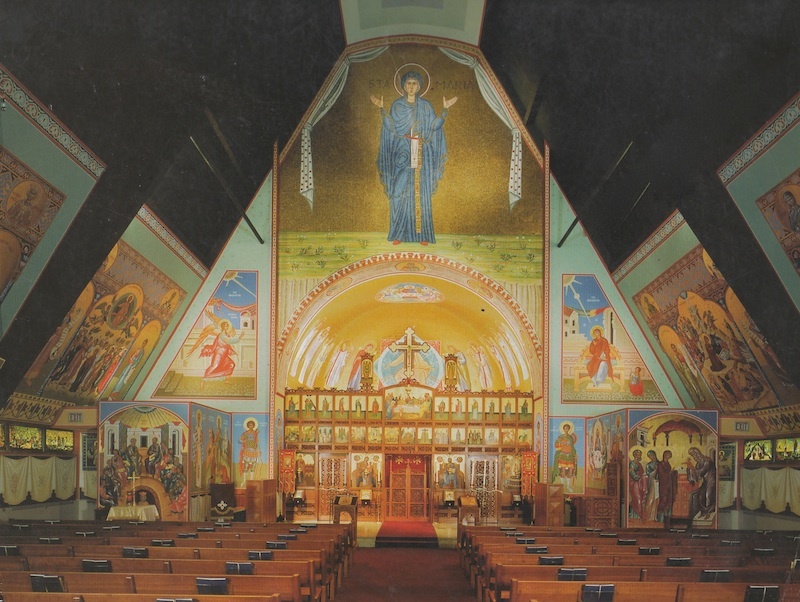Saint Mary's Romanian Orthodox Church

Founded in 1904, St. Mary's Romanian Orthodox Church was the first Romanian Orthodox parish established in the United States. Originally located on Detroit Avenue, the parish's development and eventual relocation to Warren Road parallels the story of the Romanian immigrant experience in Cleveland.
The Romanian population of Cleveland primarily emigrated from the province of Transylvania during the first fifteen years of the 20th century. The choice to leave their homeland was influenced by a combination of factors that included an economic depression and the Austro-Hungarian Empire's effort to abolish the culture of other nationalities through restrictive laws governing marriage, work, and land ownership. Most immigrants were drawn to Cleveland by the availability of work, and the promise of one day returning home to purchase land. Viewing their time in America as temporary, there was little to no emphasis placed on creating permanent structures or assimilating into the larger community. The religious needs of the Romanian immigrants were attended to by traveling Orthodox clergy or the Russian Orthodox parish of St. Theodosius in Tremont.
During this first wave of immigration, the Romanians created a network of fraternal organizations that provided assistance such as death benefits and aid for sick or injured workers. Once these organizations were in place, the immigrant community focused on the creation of churches. Announcements were distributed throughout the West Side neighborhood, and in August of 1904, 101 persons attended a constitutional meeting to establish a Romanian church. Divisions quickly formed within this congregation between Romanians of Greek-Catholic and Orthodox faiths, resulting in the founding of both St. Mary's and St. Helena's church. A Romanian Orthodox priest was assigned to the former parish, and plans were made by 1906 for the construction of the church.
At the opening service of St. Mary's Romanian Orthodox Church in August of 1908, police stood guard outside and dispersed crowds attempting to interfere with parish members entering the church. Just nights before, vandals had thrown rocks through the stained glass windows. The parish's first pastor had resigned, but was still being served warrants for libel against parish members. Plans for the church's construction had resulted in warring factions within the Romanian parish. The pastor had presented plans for a large church that cost $25,000; leading members of the parish opted for a much smaller design that would only cost $7,500. While the church was an important aspect of life, the congregation opted for the smaller structure. Much of the immigrant community was sending money to family back home, paying dues to fraternal societies, and saving their earnings to purchase land in their birthplace - they saw little need for permanent, grand structures. Supporters of the more elaborate structure desired the church to act as an anchor for the growing, transient Romanian population. Despite its turbulent beginnings, St. Mary's would play a central role within the community; it not only provided for the spiritual needs of it members, but offered a place to congregate, socialize, and develop relationships that aided newcomers to Cleveland in finding work and housing.
Romanian immigration into the United States had peaked by the beginning of World War I. With nearly 12,000 Romanians living and working in Cleveland prior to the Great War, the number would decrease by half in the years that immediately followed its conclusion. As was the case since the beginning of the 20th century, many Romanians left Cleveland once they had saved enough money to return home and purchase land; this task generally took about three years. Previously, new immigrants had replaced those that left. Following the war, however, the Immigration Act of 1924 restricted the annual number of Romanians entering the U.S. to around 600 a year. As the transient population atrophied, the number of Romanians living in Cleveland drastically declined. Additionally, the Paris Peace Treaty designated Transylvania, homeland to a majority of northeast Ohio's Romanian population, a part of Greater Romania. Many who had emigrated to escape persecution by the Austro-Hungarian Empire returned to the land of their birth.
Those remaining in America developed a permanent settlement between West 45th Street and West 65th Street that lasted until the mid century. The predominately transient male population gave way to families of Romanian descent. Even as the immigrant population dwindled, however, the church continued to grow. St. Mary's thrived by shifting its focus to meet the needs of a changing community. While in 1928 the parish had dwindled to 43 paying members, the church sponsored educational and service opportunities for the Romanian settlers and their children, and became active in promoting the preservation of its congregation's Romanian heritage. This change in focus coupled with strong pastoral leadership soon saw the church grow to over 600 members - becoming the largest parish in the Episcopate. With the growth of the church, the restraints of the original structure's size became evident. The parish hall, built in 1926, was enlarged in 1937 to provide space for dances, sports, and church programs. By 1940, planning began for the construction of a new church. Delayed by World War II, a design was finally prepared for a new structure in 1950.
Initially, the church was to be constructed at the Detroit Avenue site; parishioners called a last minute general meeting in 1954 to vote on the location. Younger members of the parish led the movement to relocate their parish to a new site on the outskirts of the city in the Westpark neighborhood. The relocation of the church reflected both the assimilation and exodus of the Romanian community from what is now the Detroit Shoreway neighborhood. As with many of Cleveland's immigrant enclaves, the process of acculturation over generations eventually weakened the community's ties to the neighborhood. With the increased prosperity of each consecutive generation, those that could afford to leave the aging city often moved away towards the suburbs. At a special meeting of parishioners called in 1954, it was overwhelmingly voted to sell the Detroit Avenue property and relocate the church at its current location on Warren Road. On August 21, 1960, the new St. Mary's Romanian Orthodox Cathedral was consecrated. The cathedral would continue to help preserve the heritage and community of the Romanian immigrants that once lived in the ethnic enclave that is now the Detroit Shoreway neighborhood. The parish would also take on new challenges and meaning as Cleveland became home to a new a new wave of Romanian immigrants following World War II.
Images







